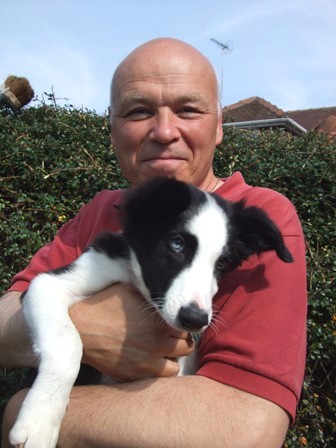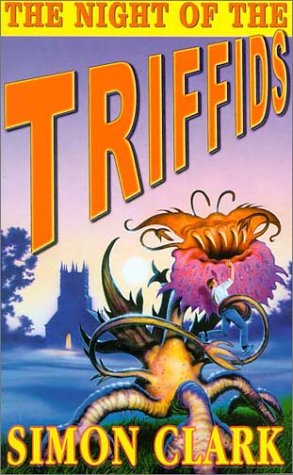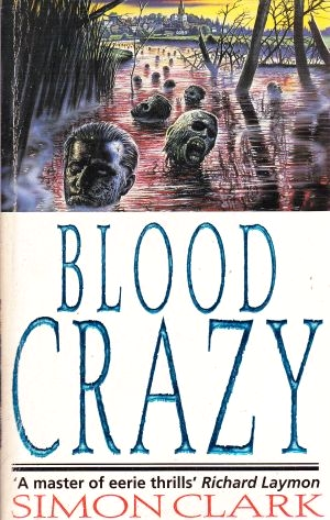

Vampyrrhic Writer Simon Clark
Gives us Five Tips for Writing Horror
IN THE "SPECIAL PAGE" ARCHIVES:
Ellen Datlow
Gerald Sanford
Joe McKinney
Ramsey Campbell
Joe R. Lansdale
Thorne & Cross
Christian A. Larsen
Five Devilishly Good Tips For Writing Horror
As Revealed By Simon Clark
So: to cut to the chase. What follows are five tips that should prove useful if you are tempted to write horror. I can’t guarantee commercial success; after all, learning the techniques of horror isn’t like learning the three-times table: there’s no mathematical correct way to calculate the scare ratio of a scene, where, for example, the young widow sees her hanged husband walking up the garden path with the noose around his neck.
Whether this scene chills the reader depends not only on the use of horror elements but inspiration drawn from the depths of the writer’s soul. I think of the combination of ‘inspiration’ and ‘craft’ something like this. Inspiration is the wild river that gushes down the hillside. Craft is the waterwheel that captures and controls (to a certain extent) that chaotic yet powerful flood. It certainly isn’t easy, and if it does come easily I fear that you might not be doing it right. After all, Arthur Machen, one of the greatest exponents of the fantastic ever, sighed regretfully, ‘We dream in fire, yet we work in clay.’
If anything here, I’ve strived to emphasise that knowing how to craft a story is important. Is it more important than natural talent, out-of-the-blue inspiration, artistic impulse? Well, that’s up for debate. But if this essay helps guide you toward writing stories that sell then I can derive satisfaction from that. Here, I want to focus largely on creating and sustaining atmosphere. We’ll summon the master once more when I quote Lovecraft: ‘Atmosphere is the all-important thing, for the final criterion of authenticity is not the dove-tailing of plot but the creation of a given sensation.’ While not wanting to disagree with a brilliant author I’d suggest that character, plot and craft are important, too. Without further ado here are those five tips:
TIP NUMBER ONE:
ATMOSPHERE: Like background music for a film, or its setting, ‘atmosphere’ should be almost a subliminal message to the reader that strange events lie ahead. In fiction ‘atmosphere’ is often conjured from the page by descriptions of place. For example, the sinister look of the house that the honeymooners approach after their car has broken down on a stormy night. Or the forbidding attic room the boy sleeps in at his uncle’s house. Or the gloomy forest the school party are lost in. If you create the right kind of atmosphere then the reader will happily accept whatever baleful monster springs forth in a few pages time. A wonderfully powerful example can be found in Poe’s ‘A Descent into the Maelstrom’. Instead of Poe glibly announcing ‘a stretch of dangerous coast’ we are confronted with a fabulous vista; this is a monumental riff on what that meeting between ocean and dry land can be: ‘To the right and left, as far as the eye could reach, there lay outstretched, like ramparts of the world, lines of horridly black and beetling cliff, whose character of gloom was but the more forcibly illustrated by the surf which reared high up against it, its white and ghastly crest, howling and shrieking for ever.’ Here cliff and sea become raging monster that has a single mission; to make you its victim -- or at least that’s the subliminal message I get in this powerhouse of writing.
In my own work I try to evoke feelings of unease, if not downright fear. In Lucifer’s Ark I aimed to prepare the reader for some extremely gruesome scenes by having the character gaze at the ocean. I hope I’ve done two jobs here. Firstly, to provide a description of the place; secondly, to suggest this is the kind of setting where bad things happen: ‘She shivered, and as she peered through the porthole she felt the coldness of that icy world reach into her to lay its deathly fingertips on her heart. The Baltic Sea was little more than a grave - one very large, very sodden, very wet grave. Hundreds of wrecked ships lay on the seabed. Aircraft by the score had plunged into it, never to be seen again.
TIP NUMBER TWO:
LOCATION: Where a story is set strongly influences atmosphere, plot and character. One set in the Arctic will evolve along different lines from one in a tropical city even if the plot is largely the same. If you are a new writer here is one tip: Have your story unfold in a place you know very well. Perhaps your old school, your local park or even in your own house. An intimate knowledge of location can make a story really come alive in ways that you couldn’t have anticipated.
TIP NUMBER THREE:
THE CRAFT. Musicians perform the work of other composers before they try their hand themselves. Writers are expected to ‘compose’ their own fiction from start of their career. It’s worth taking time to study the craft of the story. Read books on literary theory. Also, one thing I found extremely useful was to pick a story by a great writer then sit down and copy it out. No, I’m not advocating theft here. Copy out the story line by line then put the copy in a drawer. For learning the craft of writing, the balance between description and dialogue, the deployment of techniques, and so on, this will be an invaluable lesson.
TIP NUMBER FOUR:
MOOD. For me horror fiction has to be serious: no gags, no funny one-liners if the hero falls into a huge lens grinder (‘Oh my gosh, I’ve made a spectacle of myself’ See? It falls short of hilarious anyway). You can have horror-comedy, agreed, especially in films, but in books it tends to be a one-off novelty. Witty one-liners in scenes of high tension are a sure way to deflate the drama.
TIP NUMBER FIVE:
HELP ME, I’M STUCK! A common problem is the writer hitting an arid patch when the words dry up and they think ‘What happens now?’ The hero has had exciting adventures in the opening pages now he’s back home, had a shower, made some supper but suddenly the plot stops. My tip is the ‘unexpected visitor.’ This could be the arrival of figure at the door. It could be a stranger saying ‘You don’t know me but I have an important message for you.’ Or a brother in need of urgent help. Or a bad guy with a gun. It needn’t be human, of course, it could be a monster. Or even a storm, or an object falling from the sky to crash through the roof. What the ‘unexpected visitor’ does is kick-start a story.
That’s all for now. I hope these are of use to you if you plan to become a horror author, and even if you don’t, these techniques should give you an insight into how a writer works. One thing to remember about the rules of fiction technique is to learn how to use them, and once you have don’t be afraid to break them. As a writer your goal is not only to explore worlds of imagination, but to create them, too. And, to my mind, it’s the best possible job in the world.
About Simon Clark

SIMON CLARK lives in Doncaster, England. When his first novel, Nailed by the Heart, made it through the slush pile in 1994 he banked the advance and embarked upon his dream of becoming a full-time writer. Many dreams and nightmares later he wrote the cult classic Blood Crazy. Other titles include Darkness Demands, Stranger, On Deadly Ground and The Night of the Triffids, which continues the story of Wyndham’s classic The Day of the Triffids. The Night of the Triffids has been adapted as a full-cast audio drama by Big Finish.
Simon’s latest novel is Inspector Abberline & the Gods of Rome, a crime thriller featuring the real-life detective who led the hunt for Jack the Ripper.
Films, news, and tips on writing horror fiction, can be accessed at his website HERE


